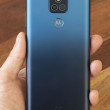PCS

(Band 2)
Personal Communications Services
1. The FCC-licensed frequency band near 1900 MHz.
Like most bands used for cellular phone service, PCS is a paired band, meaning towers transmit to phones at one frequency, while phones comunicate to towers on a different frequency.
Also like most bands used for phones, the PCS band is divided into smaller "blocks", which may be licensed by different companies in any given area. The original PCS band consisted of six blocks, assigned letters A-F and spanning 1850 - 1990 MHz. These were/are used for a variety of 2G and 3G technologies, including TDMA, GSM, CDMA, WCDMA and LTE.
In 2004, the FCC granted Sprint the use of a seventh block - block G - that includes 1910-1915 and 1990-1995 MHz. This new block is owned nationwide by Sprint, and is used for their initial deployment of LTE technology.
In the context of WCDMA and LTE networks, the standard PCS band (blocks A-F) is also known as band 2 (II). In the context of CDMA networks, the standard PCS band is known as BC1, which stands for band class 1.
The expanded PCS band used by Sprint - including blocks A-G - is known as band 25 in the context of LTE, as Sprint is using.
See: Band 25
2. PCS is also a marketing term used to describe a wide variety of two-way digital wireless service offerings operating at 1900 MHz.
Last updated Mar 31, 2016 by Rich Brome
Editor in Chief Rich became fascinated with cell phones in 1999, creating mobile web sites for phones with tiny black-and-white displays and obsessing over new phone models. Realizing a need for better info about phones, he started Phone Scoop in 2001, and has been helming the site ever since. Rich has spent two decades researching and covering every detail of the phone industry, traveling the world to tour factories, interview CEOs, and get every last spec and photo Phone Scoop readers have come to expect. As an industry veteran, Rich is a respected voice on phone technology of the past, present, and future.



